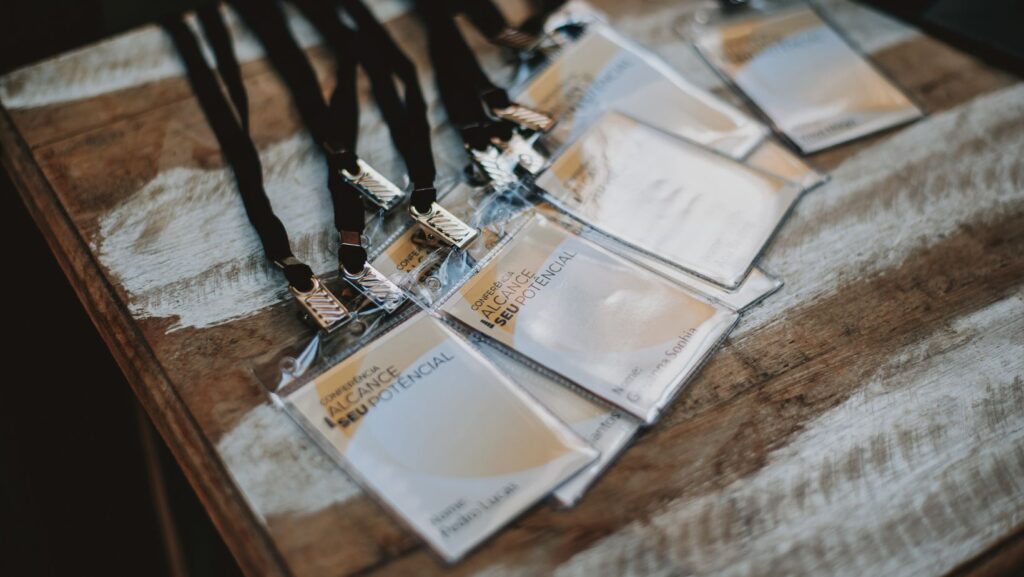As we step into 2024, event badges are evolving beyond mere identifiers into key elements of event experience. Here’s a look at the latest trends in badge design that are shaping the industry this year.
Current Trends in Event Badge Design
Bold Colors and Patterns
In 2024, event badges are embracing vibrant colors and eye-catching patterns. This trend is driven by the desire to make badges stand out and enhance the overall visual impact of events. Bold colors not only grab attention but also help in creating a memorable and engaging experience for attendees. Patterns, whether geometric or abstract, add a unique touch that reflects the theme of the event, making badges more than just functional items.
Explore 4inlanyards for sophisticated and modern badge designs that convey a sense of professionalism.
Minimalist and Functional Designs
On the flip side, there’s a strong movement towards minimalist and functional badge designs. This approach focuses on simplicity and practicality, ensuring that badges are easy to read and wear. Clean lines, limited color palettes, and straightforward layouts are key characteristics of this trend. The emphasis is on making the badge’s information clear and accessible while maintaining an elegant and refined appearance.
Interactive and Tech-Enhanced Badges
Technology is playing a significant role in the evolution of event badges. Interactive features such as QR codes and NFC (Near Field Communication) chips are becoming increasingly common. These tech-enhanced badges allow attendees to access event information, network with other participants, and engage with interactive content directly from their badges. This integration of technology not only adds convenience but also enhances the overall event experience.
Incorporating Technology in Badge Design
QR Codes and NFC Integration
QR codes and NFC integration are revolutionizing badge design by facilitating seamless interaction. QR codes can be scanned to provide instant access to digital content, schedules, and other event-related information. NFC chips enable contactless interactions, allowing attendees to simply tap their badges to exchange information or gain access to various event features.

These technological enhancements make badges more functional and interactive, streamlining the event experience for both organizers and participants.
Augmented Reality Features
Augmented Reality (AR) is another exciting development in badge design. AR features can bring badges to life by overlaying digital information on the physical badge when viewed through a smartphone or AR glasses. This could include interactive maps, multimedia content, or personalized messages, offering a unique and engaging experience that adds a new dimension to event participation.
Real-time Data and Personalization
Real-time data capabilities and personalization are also making waves in badge design. Badges equipped with real-time data features can provide live updates on event schedules, changes, or important notifications. Personalization options, such as custom greetings or tailored content based on attendee profiles, enhance the relevance and impact of the badge, making each attendee feel valued and connected.
Sustainable and Eco-Friendly Badge Options
Recycled Materials
Sustainability is a growing priority in event planning, and badge design is no exception. Many events are now opting for badges made from recycled materials. These eco-friendly options help reduce the environmental impact of events by repurposing materials that would otherwise contribute to waste. Using recycled materials not only supports environmental conservation but also aligns with the values of many attendees who are increasingly conscious of sustainability.
Biodegradable Options
Biodegradable badges are another sustainable choice gaining popularity. These badges are designed to break down naturally over time, minimizing environmental impact. Made from materials like plant fibers or bioplastics, biodegradable badges offer an eco-friendly alternative to traditional plastic options, supporting a greener approach to event management.
Reducing Waste with Digital Alternatives
Digital badges are emerging as a practical solution for reducing waste. By leveraging digital technology, event organizers can issue badges via mobile apps or digital platforms, eliminating the need for physical materials altogether.

This not only reduces waste but also provides a more flexible and efficient way to manage attendee credentials and information.
Design Tips for Maximum Impact
Ensuring Readability and Visibility
Regardless of the design trends, the primary function of a badge is to be readable and visible. Ensure that the text is large enough to be easily seen from a distance, and use contrasting colors to enhance readability. Clear and legible fonts are essential for conveying important information without causing confusion.
Balancing Aesthetics with Practicality
While innovative designs are exciting, it’s crucial to balance aesthetics with practicality. The badge should not only look appealing but also be comfortable to wear and functional. Consider factors such as badge size, attachment methods, and overall usability to ensure that the badge serves its purpose effectively.
Customization and Personal Touches
Adding a personal touch to badges can significantly enhance the attendee experience. Customization options, such as incorporating individual names, company logos, or unique designs, can make badges more meaningful and memorable. Personal touches help create a connection between attendees and the event, making them feel more engaged and valued.


More Stories
VR Technology in Live Dealer Games Could Enhance Social Interaction and Player Experience
Finest Tips To Make Your Bankroll Last Longer When Playing Online Slots
How Do Pogo Pin Connectors Compare to Other Connector Types?